- Home
- About Us
- Industry
- Services
- Reading
- Contact Us
Transport Layer Security Market: Current Analysis and Forecast (2024-2032)
Emphasis on Type (TLS 1.0, TLS 1.1, TLS 1.2, TLS 1.3, and Quantum-Resistant TLS); Product (SSL/ TLS Certificates, TLS Accelerators, TLS Software, and TLS Hardware); End-Users (Banking, Financial Services, & Insurance (BFSI), IT & Telecom, Government & Defense, Retail & E-Commerce, Healthcare, and Others); and Region/Country
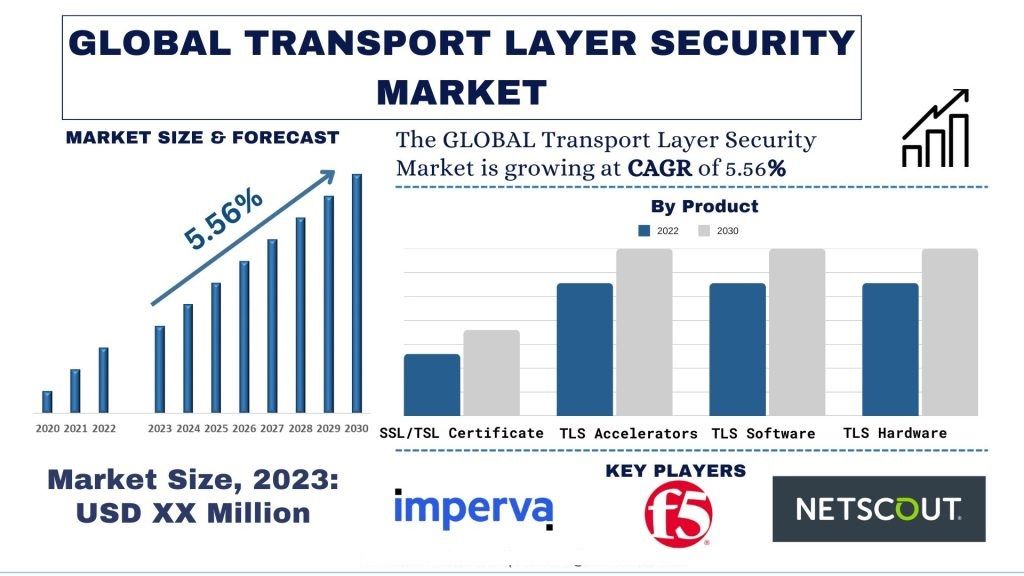
Transport Layer Security Market Size & Forecast
The transport layer security market was valued at USD XX Million and is expected to grow at a strong CAGR of around 5.56% during the forecast period (2024-2032) owing to the growing cyber security threats.
Transport Layer Security Market Analysis
Transport Layer Security (TLS) is a cryptographic protocol that provides end-to-end security for data transmitted over networks. It is the successor to the Secure Sockets Layer (SSL) protocol and is designed to ensure privacy, data integrity, and authentication between communicating applications. The primary purpose of TLS is to secure communications over a computer network by encrypting the data transmitted between two parties (e.g., a client and a server). This protects the data from being intercepted and read by unauthorized third parties, ensuring confidentiality.
In today’s digital landscape, where data is the new currency, ensuring its security during transmission has become paramount. Transport Layer Security (TLS), a cryptographic protocol that establishes secure communication channels over computer networks, has emerged as a crucial component of this endeavor. Across diverse industries, the adoption of TLS is surging, driven by a confluence of factors that underscore the imperative of data protection. The ever-increasing number of data breaches and cyber-attacks has prompted governments and regulatory bodies to implement stringent data privacy laws and regulations. These regulations mandate the use of secure communication protocols, such as TLS, to safeguard sensitive information during transmission. For instance, the General Data Protection Regulation (GDPR) in the European Union and the California Consumer Privacy Act (CCPA) in the United States have strict requirements for securing personal data, driving widespread TLS adoption across industries. According to a report by Cisco, 87% of organizations have experienced a data breach due to inadequate data protection measures. Furthermore, the widespread adoption of cloud computing and the increasing trend of remote work has necessitated secure data transmission over public networks. TLS is crucial in ensuring the confidentiality and integrity of data exchanged between clients and cloud servers or remote employees and corporate networks. As more businesses embrace cloud-based solutions and remote work arrangements, the demand for TLS has skyrocketed. Additionally, The e-commerce industry has been a significant driver of TLS adoption. Online transactions involving sensitive financial information and personal data require robust security measures to protect against data breaches and identity theft. TLS encrypts the communication between web browsers and servers, ensuring that sensitive data remains confidential during transmission.
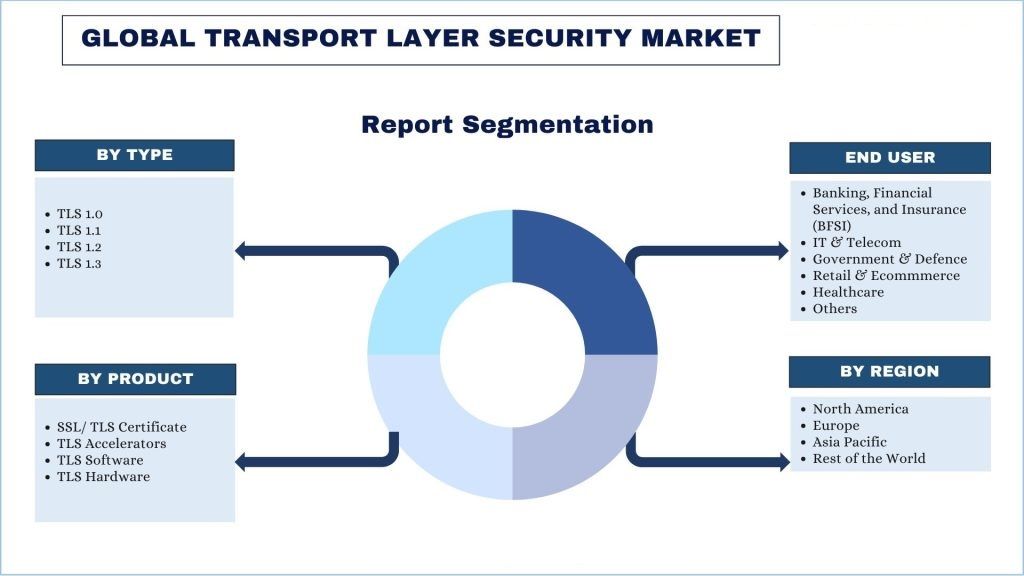
Transport Layer Security Market Trends
This section discusses the key market trends that are influencing the various segments of the Transport Layer Security Market as identified by our team of research experts.
The Banking, Financial, & Insurance (BFSI) sector established itself as a major end-user segment for the Transport Layer Security Industry worldwide.
The Banking, Financial Services, and Insurance (BFSI) sector is the major end-user for TLS in the global market. The BFSI sector handles sensitive financial data, personal information, and transaction details, making data security a paramount concern. Strict regulatory frameworks, such as the Payment Card Industry Data Security Standard (PCI-DSS), the Gramm-Leach-Bliley Act (GLBA), and the Sarbanes-Oxley Act (SOX), mandate the implementation of robust security measures, including encryption protocols like TLS, to protect customer data and ensure compliance. Furthermore, the BFSI industry has undergone a significant digital transformation, with online and mobile banking applications becoming increasingly popular. TLS is essential for securing these online platforms, ensuring that customers can access their accounts and perform transactions securely over the internet. Additionally, the BFSI sector is a prime target for cyber threats, such as hacking attempts, data breaches, and cyber-attacks. TLS serves as a crucial defense mechanism, protecting sensitive data and communications from potential cyber threats, thereby safeguarding the reputation and trust of financial institutions. Factors such as these have established the BFSI sector as a leading adopter of TLS solutions worldwide.
North America Emerges as the Largest Market for Transport Layer Security Worldwide.
Within North America, the United States of America holds the major portion of the Transport Layer Security market of North America. The major factor boosting the market’s growth is its leadership position in the technology industry globally. Furthermore, the United States of America is home to some of the biggest banking and financial institutions in the world, fueling the need for transport layer security infrastructure.
. North America, particularly the United States, has emerged as one of the leading adopters and holds a significant portion of the Transport Layer Security (TLS) market globally. North America, with its strong emphasis on innovation and technological progress, was an early adopter of TLS solutions. Companies in this region were quick to recognize the importance of secure communication and data protection, driving the adoption of TLS across various industries. Furthermore, North America, especially the United States, has robust data privacy and security regulations, such as the Health Insurance Portability and Accountability Act (HIPAA), the Payment Card Industry Data Security Standard (PCI DSS), and the General Data Protection Regulation (GDPR). For instance, In FY 2024, DHS allocated over USD 3 billion to cybersecurity, making it the top-funded agency among CFO act government agencies, excluding DoD. Overall, cybersecurity expenditure in the US increased in 2023, with total agency funding estimated at USD 10.46 billion. These regulations mandate the implementation of secure communication protocols like TLS, driving its widespread adoption. Additionally, the region boasts a well-developed internet infrastructure and high internet penetration rates. For instance, according to the International Telecommunication Union (ITU), the United States had an internet penetration rate of 90% in 2021, one of the highest in the world. Enabling the seamless deployment and utilization of TLS solutions across various sectors, such as e-commerce, healthcare, and finance, contributes to the growth of TLS in the region. Lastly, North America is home to several leading technology companies, including giants like Microsoft, Amazon, Apple, and Google. These companies have been at the forefront of developing and implementing TLS solutions, contributing to the region’s dominance in the market.
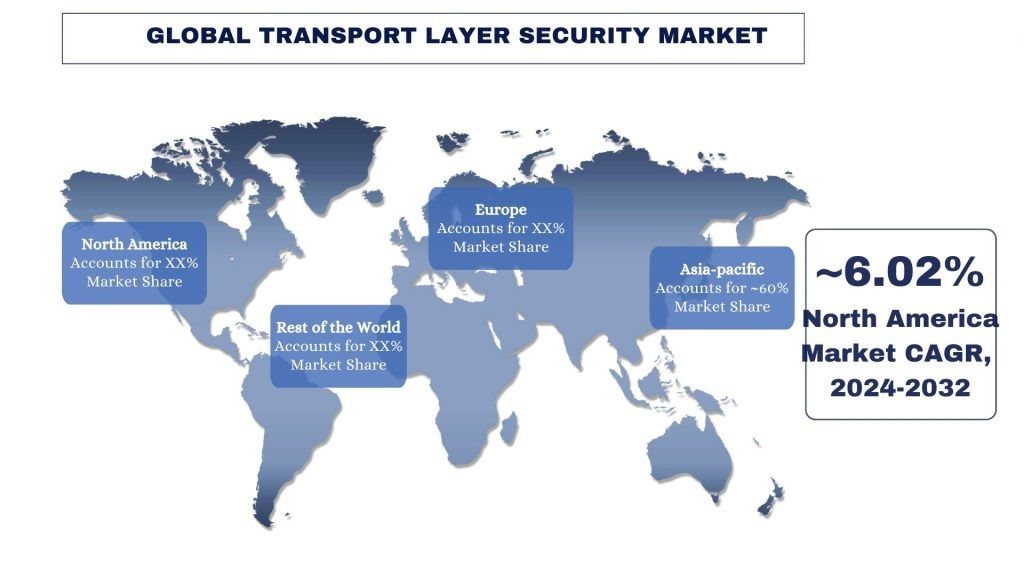
Transport Layer Security Industry Overview
The transport layer security market is competitive and fragmented, with the presence of several global and international market players. The key players are adopting different growth strategies to enhance their market presence, such as partnerships, agreements, collaborations, new product launches, geographical expansions, and mergers and acquisitions. Some of the major players operating in the market are Imperva, F5, Inc., NETSCOUT, Nexusguard, VeriSign, Inc., TransUnion LLC, and NSFOCUS.; Akamai Technologies; Cloudflare, Inc.; and Link11
Transport Layer Security Market News
- In May 2023, Teleport introduced Teleport 13, which brings forth automatic vulnerability patching and improved DevOps security. The notable features of Teleport 13 encompass Transport Layer Security routing, the capability to import applications/groups from Okta, and AWS OpenSearch support for secure database access.
- In April 2023, AWS announced support for TLS 1.3 in AWS IoT Core, offering improved security and performance compared to TLS 1.2. Customers can configure the TLS version for their default Amazon Trust Services (ATS) data plane endpoint and configurable endpoints, allowing for simultaneous operation of TLS 1.2 and TLS 1.3 on a single or multiple data endpoints.
Transport Layer Security Market Report Coverage
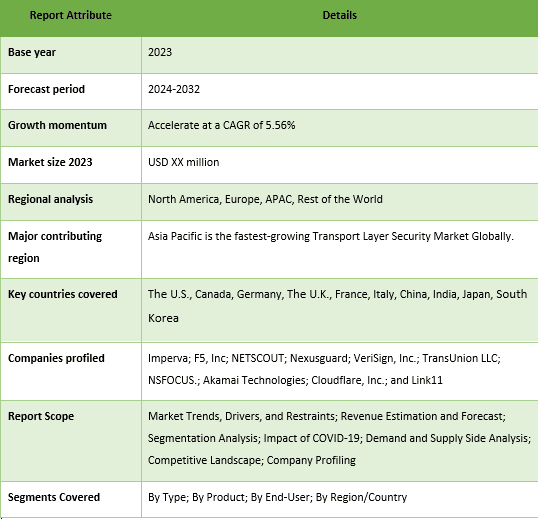
Transport Layer Security Market Report Coverage Reasons to buy this report:
- The study includes market sizing and forecasting analysis validated by authenticated key industry experts.
- The report presents a quick review of overall industry performance at one glance.
- The report covers an in-depth analysis of prominent industry peers with a primary focus on key business financials, product portfolios, expansion strategies, and recent developments.
- Detailed examination of drivers, restraints, key trends, and opportunities prevailing in the industry.
- The study comprehensively covers the market across different segments.
- Deep dive regional level analysis of the industry.
Customization Options:
The global Transport Layer Security market can further be customized as per the requirement or any other market segment. Besides this, UMI understands that you may have your own business needs; hence, feel free to contact us to get a report that completely suits your requirements.
Table of Content
Research Methodology for the Transport Layer Security Market Analysis (2024-2032)
Analyzing the historical market, estimating the current market, and forecasting the future market of the global Transport Layer Security market were the three major steps undertaken to create and analyze the adoption of Transport Layer security` in major regions globally. Exhaustive secondary research was conducted to collect the historical market numbers and estimate the current market size. Secondly, to validate these insights, numerous findings and assumptions were taken into consideration. Moreover, exhaustive primary interviews were also conducted with industry experts across the value chain of the global Transport Layer Security market. Post assumption and validation of market numbers through primary interviews, we employed a top-down/bottom-up approach to forecasting the complete market size. Thereafter, market breakdown and data triangulation methods were adopted to estimate and analyze the market size of segments and sub-segments of the industry pertains to. Detailed methodology is explained below:
Analysis of Historical Market Size
Step 1: In-Depth Study of Secondary Sources:
A detailed secondary study was conducted to obtain the historical market size of the Transport Layer Security market through company internal sources such as annual reports & financial statements, performance presentations, press releases, etc., and external sources including journals, news & articles, government publications, competitor publications, sector reports, third-party database, and other credible publications.
Step 2: Market Segmentation:
After obtaining the historical market size of the Transport Layer Security market, we conducted a detailed secondary analysis to gather historical market insights and share for different segments & sub-segments for major regions. Major segments are included in the report as type, product, and end-users. Further country-level analyses were conducted to evaluate the overall adoption of testing models in that region.
Step 3: Factor Analysis:
After acquiring the historical market size of different segments and sub-segments, we conducted a detailed factor analysis to estimate the current market size of the Transport Layer Security market. Further, we conducted factor analysis using dependent and independent variables such as type, product, and Transport Layer Security market end-users. A thorough analysis was conducted of demand and supply-side scenarios considering top partnerships, mergers and acquisitions, business expansion, and product launches in the Transport Layer Security market sector across the globe.
Current Market Size Estimate & Forecast
Current Market Sizing: Based on actionable insights from the above 3 steps, we arrived at the current market size, key players in the global Transport Layer Security market, and market shares of the segments. All the required percentage shares split and market breakdowns were determined using the above-mentioned secondary approach and were verified through primary interviews.
Estimation & Forecasting: For market estimation and forecast, weights were assigned to different factors including drivers & trends, restraints, and opportunities available for the stakeholders. After analyzing these factors, relevant forecasting techniques, i.e., the top-down/bottom-up approach, were applied to arrive at the market forecast for 2032 for different segments and sub-segments across the major markets globally. The research methodology adopted to estimate the market size encompasses:
- The industry’s market size, in terms of revenue (USD) and the adoption rate of the Transport Layer Security market across the major markets domestically
- All percentage shares, splits, and breakdowns of market segments and sub-segments
- Key players in the global Transport Layer Security market in terms of products offered. Also, the growth strategies adopted by these players to compete in the fast-growing market.
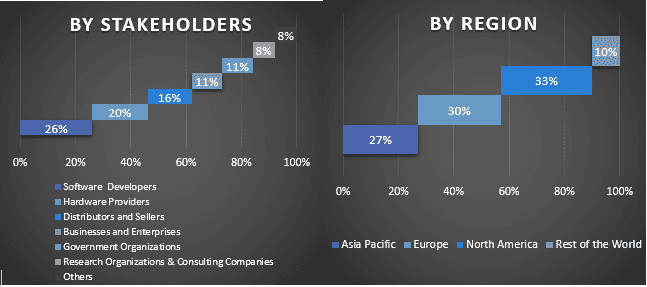
Transport Layer Security Market Graph
Market Size and Share Validation
Primary Research: In-depth interviews were conducted with the Key Opinion Leaders (KOLs), including Top Level Executives (CXO/VPs, Sales Head, Marketing Head, Operational Head, Regional Head, Country Head, etc.) across major regions. Primary research findings were then summarized, and statistical analysis was performed to prove the stated hypothesis. Inputs from primary research were consolidated with secondary findings, hence turning information into actionable insights.
Split of Primary Participants in Different Regions
Market Engineering
The data triangulation technique was employed to complete the overall market estimation and arrive at precise statistical numbers for each segment and sub-segment of the global Transport Layer Security market. Data was split into several segments and sub-segments after studying various parameters and trends in the areas of type, product, and end-users in the global Transport Layer Security market.
The main objective of the Global Transport Layer Security Market Study
The current & future market trends of the global Transport Layer Security market were pinpointed in the study. Investors can gain strategic insights to base their discretion for investments on the qualitative and quantitative analysis performed in the study. Current and future market trends determined the market’s overall attractiveness at a regional level, providing a platform for the industrial participant to exploit the untapped market to benefit from a first-mover advantage. Other quantitative goals of the studies include:
- Analyze the current and forecast market size of the Transport Layer Security market in terms of value (USD). Also, analyze the current and forecast market size of different segments and sub-segments.
- Segments in the study include areas of type, product, and end-users.
- Define and analyze the regulatory framework for the Transport Layer Security
- Analyze the value chain involved with the presence of various intermediaries, along with analyzing customer and competitor behaviors of the industry
- Analyze the current and forecast market size of the Transport Layer Security market for the major regions
- Major countries of regions studied in the report include Asia Pacific, Europe, North America, and the Rest of the World
- Company profiles of the Transport Layer Security market and the growth strategies adopted by the market players to sustain in the fast-growing market.
- Deep dive regional level analysis of the industry
Frequently Asked Questions FAQs
Q1: What is the current market size and growth potential of the global Transport Layer Security market?
Q2: What are the driving factors for the growth of the global Transport Layer Security Market?
Q3: Which segment holds the major portion of the global Transport Layer Security market by End-User?
Q4: What are the emerging technologies and trends in the global Transport Layer Security market?
Q5: Which region will be the fastest-growing global Transport Layer Security market?
Q6: Who are the key players in the global Transport Layer Security market?
Related Reports
Customers who bought this item also bought










